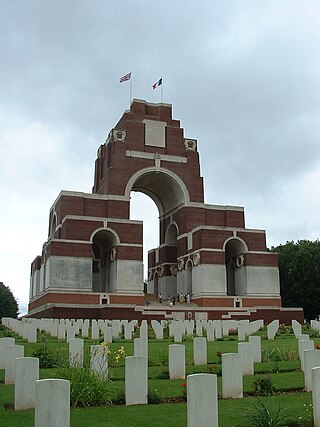
The Thiepval Memorial to the Missing of the Somme is a war memorial to 72,337 missing British and South African servicemen who died in the Battles of the Somme of the First World War between 1915 and 1918, with no known grave. It is near the village of Thiepval, Picardy in France. A visitors' centre opened in 2004. Designed by Sir Edwin Lutyens, Thiepval has been described as "the greatest executed British work of monumental architecture of the twentieth century".
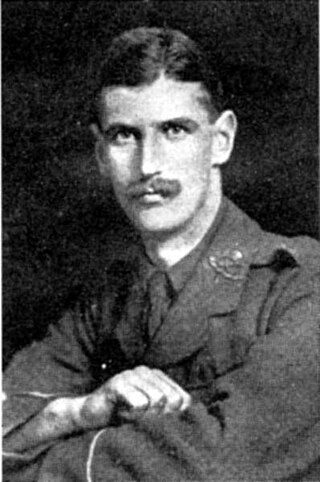
John Leslie Green VC was an English recipient of the Victoria Cross, the highest and most prestigious award for gallantry in the face of the enemy that can be awarded to British and Commonwealth forces. An officer in the Royal Army Medical Corps, he served on attachment to The Sherwood Foresters during the First World War. He was posthumously awarded the VC for his actions on 1 July 1916, during the Battle of the Somme.

David Jones VC was an English recipient of the Victoria Cross, the highest and most prestigious award for gallantry in the face of the enemy that can be awarded to British and Commonwealth forces. A soldier with The King's (Liverpool) Regiment during the First World War, he was awarded the VC for his actions in September 1916, during the Battle of the Somme. He was killed in action several days later.

The Cross of Sacrifice is a Commonwealth war memorial designed in 1918 by Sir Reginald Blomfield for the Imperial War Graves Commission. It is present in Commonwealth war cemeteries containing 40 or more graves. Its shape is an elongated Latin cross with proportions more typical of the Celtic cross, with the shaft and crossarm octagonal in section. It ranges in height from 18 to 24 feet. A bronze longsword, blade down, is affixed to the front of the cross. It is usually mounted on an octagonal base. It may be freestanding or incorporated into other cemetery features. The Cross of Sacrifice is widely praised, widely imitated, and the archetypal British war memorial. It is the most imitated of Commonwealth war memorials, and duplicates and imitations have been used around the world.

Foncquevillers is a commune in the Pas-de-Calais department in the Hauts-de-France region of France.
Rocquigny-Equancourt Road British Cemetery is a war grave for mainly Commonwealth soldiers who died in the First World War. It was designed by Sir Reginald Blomfield in the 1920s and contains the bodies of 2,046 people: 1,817 identified Commonwealth casualties plus 21 unidentified casualties; also 198 German casualties and 10 French civilians.

Mierlo War Cemetery is a Second World War Commonwealth war grave cemetery, located in the village of Mierlo, 12 km (7.5 mi) east of Eindhoven in The Netherlands.
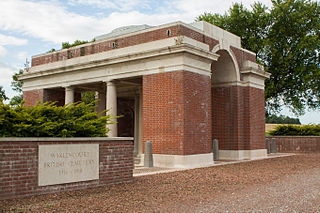
Warlencourt British Cemetery is a Commonwealth War Graves Commission burial ground for military personnel who died on the Western Front during the First World War. It is located in the Pas de Calais region of France. Established in 1919 to consolidate several smaller cemeteries, it was designed by Sir Edward Lutyens and is administered by the Commonwealth War Graves Commission (CWGC). There are 3,450 soldiers interred, over which 1,823 are unidentified. There are also memorials to 55 soldiers whose graves are unknown. The majority of the soldiers who have been identified are British, with smaller numbers of Australians, South Africans, New Zealanders, and Canadians.

AIF Burial Ground is a Commonwealth War Graves Commission burial ground for the dead of the First World War located near Flers on the Somme in France.
Bancourt British Cemetery is a Commonwealth War Graves Commission burial ground for the dead of the First World War located in the Pas de Calais region of France, on the Western Front.
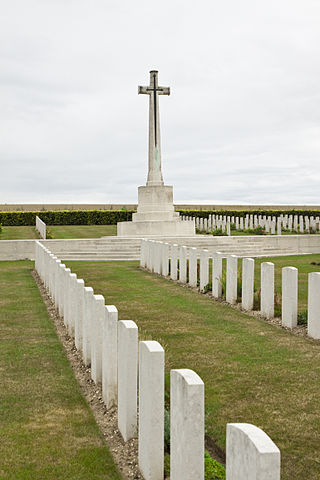
Abbeville Communal Cemetery Extension is a Commonwealth War Graves Commission burial ground for the dead of the First World War and Second World War located near Abbeville, in the Somme region of France. It is adjacent to the Abbeville Communal Cemetery.

Abbeville Communal Cemetery is a Commonwealth War Graves Commission burial ground for the dead of the First World War and Second World War located near Abbeville, in the Somme department of France. It is adjacent to the Abbeville Communal Cemetery Extension.
Couin New British Cemetery is a Commonwealth War Graves Commission (CWGC) burial ground for military personnel who died on the Western Front during the First World War. It is located in the Pas de Calais region of France. Established in 1917, it was designed by Sir Reginald Blomfield and is administered by the Commonwealth War Graves Commission. There are 363 soldiers of the First World War interred in the cemetery, including two from Germany.
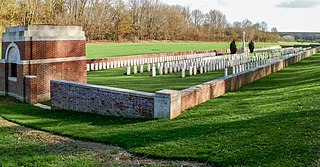
Norfolk Cemetery is a Commonwealth War Graves Commission (CWGC) burial ground for the dead of the First World War. It is located at the village of Bécordel-Bécourt, near Albert in the Somme department of France.

Dantzig Alley British Cemetery is a Commonwealth War Graves Commission burial ground for the dead of the First World War. It is located near the village of Mametz, eight kilometres from Albert in the Somme department of France.
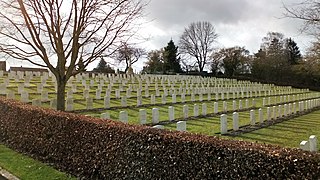
The Aveluy Communal Cemetery Extension is a cemetery located in the Somme region of France commemorating French and British Commonwealth troops who fought in the Battle of the Somme in World War I. The cemetery honors mainly soldiers who died holding the line near the village of Aveluy from slightly before July 1915 to 26 March 1918.

The Bertrancourt Military Cemetery is a cemetery located in the Somme region of France commemorating British and Commonwealth soldiers who fought in World War I. The cemetery is maintained by the Commonwealth War Graves Commission and contains mainly those who died on the front line near the village of Bertrancourt in 1916, 1917, and June–August 1918.
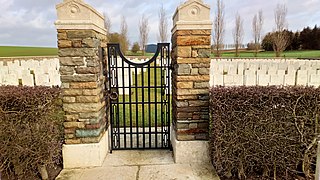
The Bouzincourt Communal Cemetery Extension is a cemetery located in the Somme region of France commemorating British and Commonwealth soldiers who fought in the Battle of the Somme in World War I. The cemetery contains mostly those who died between May 1916 and February 1917 and between March and September 1918 on the front line near the village of Bouzincourt. The cemetery is managed by the Commonwealth War Graves Commission.

The Bray Military Cemetery is a military cemetery located in the Somme region of France commemorating British and Commonwealth soldiers who fought in the Battle of the Somme in World War I. The cemetery contains mainly those who died from April to March 1916 and in August 1918 near the village of Bray-sur-Somme and over the course of the war in the surrounding area.

Mailly Wood Cemetery is a military cemetery with casualties from the First World War, located in the French village of Mailly-Maillet (Somme). It is maintained by the Commonwealth War Graves Commission.

















